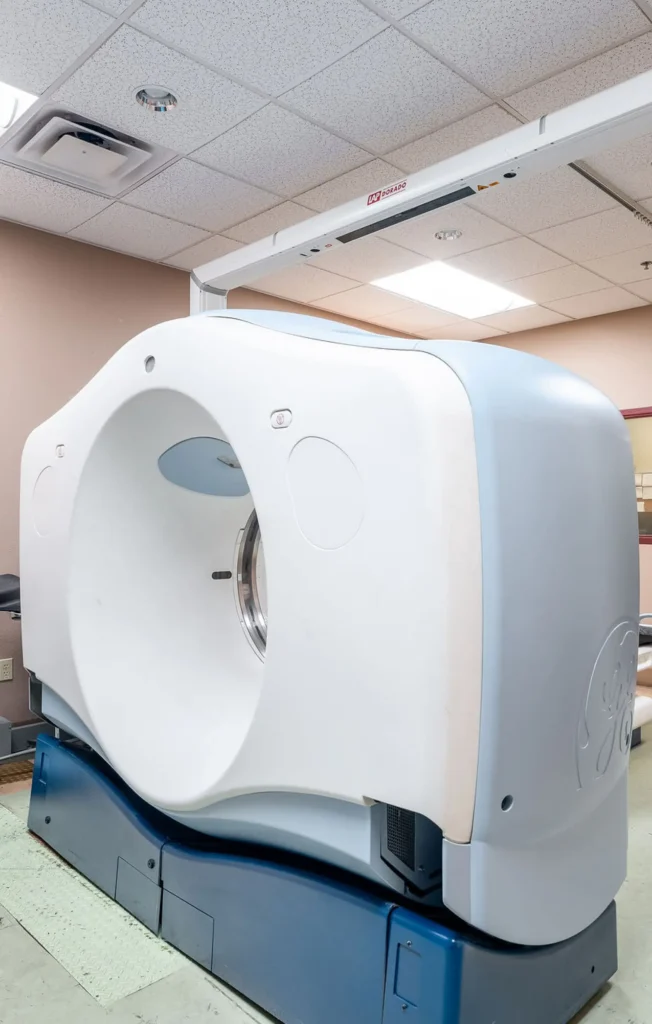Stereotactic Radiosurgery (SRS)
A highly precise and minimally invasive procedure that uses radiation to treat small, targeted areas of the body, typically in the brain or spine.
What is SRS?
Stereotactic Radiosurgery (SRS) is a non-surgical, highly precise form of radiation therapy used to treat tumors and lesions in the brain, spine, and other parts of the body. By using advanced imaging and computer-guided technology, SRS delivers multiple beams of high-dose radiation that converge on the tumor from different angles. This allows for an exceptionally focused treatment while sparing nearby healthy tissue.
How It Works
Detailed Imaging & Planning
Your treatment begins with advanced imaging—such as MRI or CT scans—to create a 3D model of your tumor and surrounding anatomy. This data enables our team to plan a highly targeted treatment blueprint specifically for you.
Pinpoint Beam Delivery
During treatment, the linear accelerator delivers multiple beams of radiation from carefully chosen angles. These beams converge on the tumor with sub-millimeter precision, allowing a potent dose to the target area while minimizing impact to healthy structures.
Single or Limited Sessions
Unlike conventional radiation therapy, which is delivered over many sessions, SRS often requires only one session—or just a few treatments—making it more convenient for patients and reducing overall treatment time.
Benefits of SRS
Exceptional Precision
Treats small or hard-to-reach tumors near critical organs with sub-millimeter accuracy.
Non-Invasive Alternative
Provides a powerful treatment option for patients who may not be candidates for surgery.
Fewer Treatments
Delivers a high dose of radiation in one or a few sessions, reducing disruption to your daily life.
Reduced Side Effects
By sparing healthy tissue, SRS can lower the risk of complications compared to traditional radiation.

Common Uses for SRS
SRS is often recommended for:
Brain tumors and metastases
Spinal tumors
Certain head and neck cancers
Arteriovenous malformations (AVMs)
Tumors located near sensitive structures
What to Expect During Treatment
Simulation Session
We’ll position you using specialized equipment (like custom masks or head frames) to ensure accuracy.
Treatment Duration
Most SRS sessions last between 30–90 minutes, depending on the size and location of the tumor.
Follow-Up
Your care team will monitor you closely after treatment to evaluate your response and plan next steps if needed.
Learn More About Radiant Cancer Center
With our office based out of Rancho Mirage, our treatment center is conveniently located to serve the entire Coachella Valley.
Every step of your care is monitored and adjusted to ensure the highest accuracy.
Other Services We Offer
Interested in exploring other precision-focused radiation therapies?
Intensity‑Modulated Radiation Therapy (IMRT)
Advanced radiation treatment designed to target tumors with precision while protecting healthy tissue.
Surface-Guided Radiation Therapy (SGRT)
Uses 3D camera systems to monitor patient surface motion in real-time. SGRT enhances accuracy and safety by automatically pausing treatment if movement exceeds designated thresholds.
Image-Guided Radiation Therapy (IGRT)
Utilizes advanced imaging (e.g., CT, MRI, PET) before and during treatment to ensure radiation targets the exact tumor location, reducing margins and improving accuracy.
